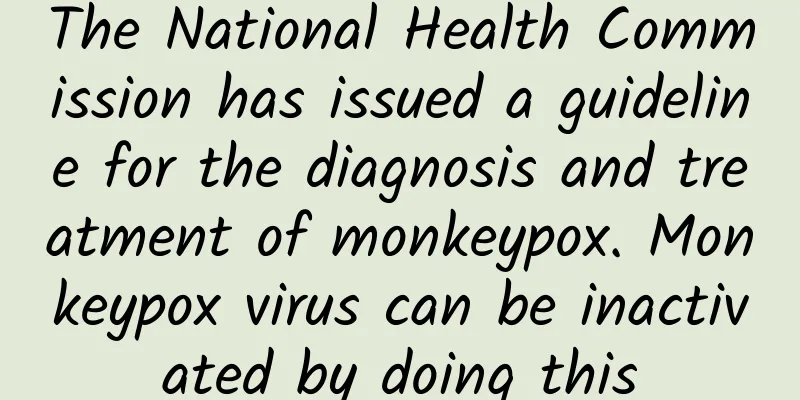The National Health Commission has issued a guideline for the diagnosis and treatment of monkeypox. Monkeypox virus can be inactivated by doing this

|
Xinhua News Agency, Beijing, June 15 (Reporters Xu Penghang and Tian Xiaohang) Since May this year, monkeypox cases have been reported in many non-endemic countries in the world, and community transmission has occurred. In order to prepare for the medical response to monkeypox in advance and improve the clinical early identification and standardized diagnosis and treatment capabilities, the National Health Commission, together with the State Administration of Traditional Chinese Medicine, organized the formulation of the "Monkeypox Diagnosis and Treatment Guidelines (2022 Edition)" and released it to the public. The guideline states that monkeypox is a zoonotic viral disease caused by monkeypox virus infection, with clinical manifestations mainly including fever, rash, and swollen lymph nodes. The main source of infection is rodents infected with monkeypox virus. Primates (including monkeys, chimpanzees, and humans) can also become sources of infection after infection. (Copyrighted image from the gallery, no permission to reprint) How is monkeypox virus spread? The guidelines point out that the virus enters the human body through mucous membranes and broken skin. People are mainly infected through contact with infected animal lesions, blood, other body fluids, or bites and scratches from infected animals. It is mainly transmitted between people through close contact, but can also be transmitted through droplets, contact with objects contaminated by the virus, and vertical transmission through the placenta. Sexual transmission cannot be ruled out. What are the symptoms of monkeypox? According to the guidelines, chills and fever occur in the early stage of the disease, with body temperature mostly above 38.5°C, and may be accompanied by headache, drowsiness, fatigue, back pain and myalgia. Most patients experience swollen lymph nodes in the neck, armpits, groin and other parts. Rash appears 1 to 3 days after onset. It takes about 2 to 4 weeks from onset to scab shedding. Some patients may develop complications, including secondary bacterial infection at the site of skin lesions, bronchopneumonia, encephalitis, corneal infection, sepsis, etc. The guidelines point out that monkeypox is a self-limiting disease with a good prognosis in most cases. Severe cases are common in young children and people with weakened immune systems, and the prognosis is related to the infected virus branch, the degree of virus exposure, previous health conditions, and the severity of complications. People who have been vaccinated against smallpox have a certain degree of cross-protection against monkeypox virus. The guidelines clearly state that suspected and confirmed cases should be placed in isolation wards. Suspected cases should be isolated in single rooms. Patients can be discharged from the hospital when their body temperature is normal, their clinical symptoms have improved significantly, and the scabs have fallen off. Source: Xinhuanet |
<<: If the earth stopped rotating, where could we survive?
Recommend
Customized video of a foreigner shouting "Happy Birthday"! Creatively customized video of a black African child holding a sign to wish a happy birthday!
Our African team is professional in shooting bles...
2018 WeChat Open Class, what key points should marketers pay attention to?
On January 15, 2018, Zhang Xiaolong 's speech...
Marketing hotspots and advertising suggestions in August!
Chinese Valentine's Day, the start of the sch...
How to promote and attract traffic to the member points mini program?
The points app has always been a common marketing...
APP promotion: building user levels from 0 to 1
A useful or interesting APP user rating system ca...
Baidu Apollo autonomous driving is accelerating its implementation, and smart cars are expanding the in-car entertainment ecosystem
Autonomous driving is getting closer and closer. ...
Returning to the Moon, Astronauts Face More Challenges
Recently, the Japan Aerospace Exploration Agency ...
What is the idea of Baidu's bidding promotion? Given a Baidu promotion account, what method should I use to promote it? It would be best if you can tell me the general process.
(1). Baidu has roughly three types of promotion: ...
Understand in one article丨What are the "through holes" and "blind holes" on the drilled screen mobile phone?
This month, a total of two hole-punch screen mobi...
Analysis of Zhang’s popular short video operations!
Many people have discussed why Zhang became so po...
The productivity secrets of Buffett, Jobs, and Musk
[[154413]] Being a CEO of one company is not easy...
How many people can the earth support?
As early as 2012, the academic journal Journal of...
Monthly sales of new energy vehicles hit a record high, and overseas sales exceeded last year's total sales. In November, SAIC sold 515,000 vehicles
(Shanghai, December 6, 2023) Today, SAIC Motor re...
Houdi e-commerce live broadcast account creation course, the underlying logic of starting a live broadcast with zero fans and zero works, and the live broadcast exploded the square traffic in five days
Houdi e-commerce live broadcast account creation ...
Subvert your cognition! To prevent Alzheimer's disease, you may only need one shot of vaccine? !
As the aging process of the population accelerate...









